MENU
MENU
Tea production area: Nishio City, Toyota City, Shirosato Town
Brand name of tea: Nishio no Matcha, Asuke-kancha
Types of tea: Matcha, tencha, sencha (steamed green tea), gyokuro (high quality shaded tea), kukicha (stem tea), hojicha (roasted green tea), bancha, black tea, kancha, flavored tea, etc..
Nishio no matcha (西尾の抹茶 Nishio’s matcha)
The Nishi-Mikawa region centered in Nishio City is a famous production area for matcha. Tencha, which is the raw material of matcha, is produced in Nishio City, Toyota City and Shinsiro City. Sencha is produced in Shinshiro City, Toyota City and Tahara City.
How is matcha produced?
Tencha is one type of steamed green tea. Matcha is made by grinding tencha with a stone mill or ball mill to turn fine particles into powder.
Tea gardens of tencha are covered with black man-made mats or straw mats to block sunlight for a couple of weeks before plucking. When sunlight is blocked, catechins (bitterness components) are suppressed, and amino acids (umami components) increase.
Sencha tea leaves are rolled after steaming. On the other hand, tencha tea leaves are not rolled, which suppresses bitterness.

Inariyama Chaen Park in Nishio City (August 2017)
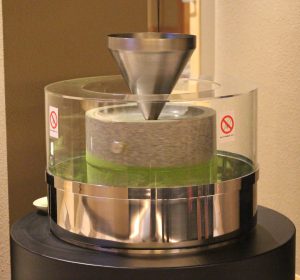
Tencha being ground with a stone mill at Matcha Museum “Saijoen WakuWaku” in Nishio City (September 2017)
Tea history of Nishio City
It is said that the origin of tea in Nishio City was through a Buddhist monk, Shoichi Kokushi. He was the founder of Jissoji-temple and also planted tea seeds. After that, Jundo Adachi, chief priest of Kojuin-temple, brought tea seeds back to Nishio from Uji in Meiji 5 (1872), and tea became a thriving industry.
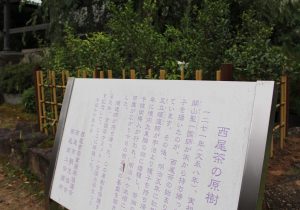
The origin of tea plant of Nishio tea at Koujuin-temple (September 2017)
Matcha cafés
There are many matcha cafes in Nishio City where you can enjoy matcha drinks and sweets.
Some matcha factories accept visitors for factory tours. Matcha Museum “Saijoen Wakuwaku” is a hands-on museum where visitors can see the matcha factory, experience grinding matcha with a stone mill and making matcha with a chasen, a bamboo tea whisk (advance booking is needed).
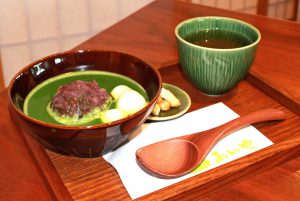
Matcha zenzai at Saijoen Matcha cafe (August 2017)
Zenzai is sweet Azuki bean soup
There is a matcha colored post box at Igetaya Park, Nishio City.
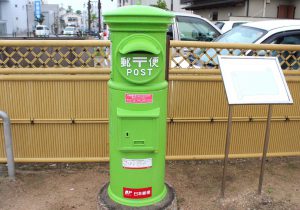
Itageya Park in Nishio City (August 2017)
Asuke-kancha 足助寒茶
There are native tea plants in the mountainous area of the Higashi Mikawa region. In olden days when people worked in the mountains, they took their breaks with tea. The tea was made from leaves of the wild plants in the mountain. The way of making tea was simple, by picking tea leaves and roasting them a little over a fire, then putting them into boiled water in a pot or kettle.
Tea has been produced in the coldest season in Asuke Town, Toyota City, which is a part of the Higashi Mikawa region. The tea is called Asuke-kancha. Kancha means cold tea. Tea branches with leaves are cut using a sickle, steamed in a large wooden bucket, then dried outdoors.
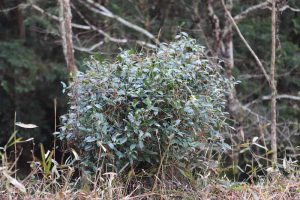
Native tea plants in Asuke Town (January 2020)
A workshop for making Asuke-kancha
A workshop for making Asuke-kancha has been held every January at Sanshu Asuke Yashiki in Asuke Town. The flavor of Asuke-kancha is different depending on the place where the tea plants grow, people who make it, etc. Asuke-kancha has a wide range of flavor. Some have strong bitterness, and some have a fruity flavor.

A Workshop of making Asuke-kancha at Sanshu Asuke Yashiki (January 2020)
Pottery industry of Aichi Prefecture
Aichi Prefecture is famous for its ceramic and pottery products, such as Tokoname ware and Seto ware. They provide varieties of kyusu, which is a Japanese tea pot with reasonable price.
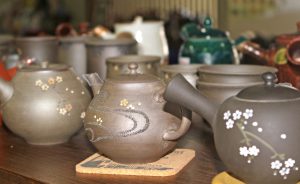
Tokoname Kyusukan (August 2017)
Related article on the site:
Tea mascot Yuru-Chara: Ma-chan (Nishio City Kanko kyokai 西尾市観光協会)
Tea related event:
Tea related facilities:
一般社団法人西尾市観光協会 稲荷山茶園公園
http://nishiokanko.com/list/shop/inariyama
あいや https://www.matcha.co.jp
抹茶ミュージアム「西条園和く和く」 https://museum.saijoen.jp
三州足助屋敷 http://asukeyashiki.jp
とこ販売 常滑急須館 https://www.tokohan.co.jp/
Ceramic and pottery art: Tokoname ware, Seto ware and Akazu ware、瀬戸焼、赤津焼
Reference:
松下智 (平成3年) 日本名茶紀行 (初版) 雄山閣出版
高野實・谷本陽蔵・富田勲・中川致之・岩浅潔・寺本益英・山田新市 (2005) 緑茶の事典 (改訂3版) 柴田書店
大森正司、阿南豊正、伊勢村護、加藤みゆき、滝口明子、中村羊一郎編(2017) 茶の事典 初版第一刷 朝倉書店
*When visiting the shops and facilities introduced in this article, please check the business hours on their website, etc. before visiting.
*The information provided on this site may be updated. If you find any information in this article that is incorrect, new, or incomplete, please contact CHAMART.
*The site does not describe all “Teas of Japan” or all “Teas of the World”. Additionally, each article expresses the writer’s personal experience and feelings.
#Aichi #nishionomatcha #asukekancha #matcha